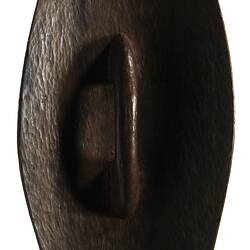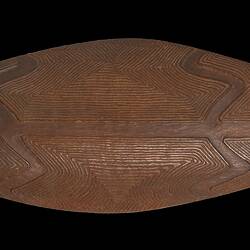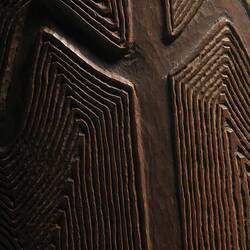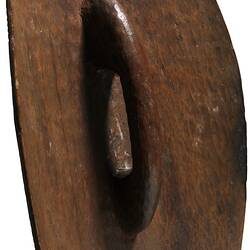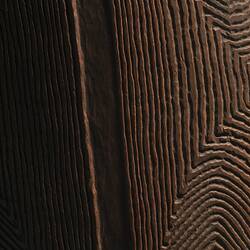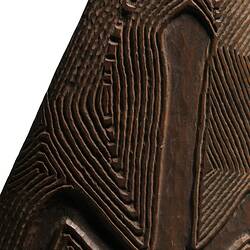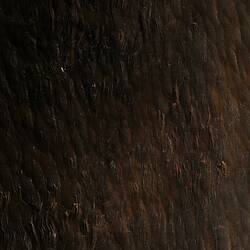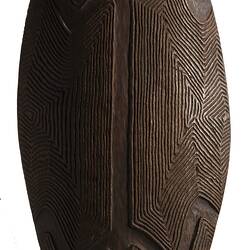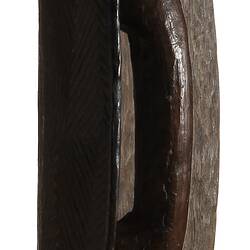Summary
Master carvers from the Namoi and Upper Darling Rivers were renowned for their representations of totemic figures and landscapes they etched into their shields. The face of this shield has been elaborately engraved with a design, possibly a large lizard.
The Kamilaroi carver has skilfully engraved the lizard, so it appears to be moving. The incised lines surrounding it represent features of the landscape, including rivers and contours that convey to others the name or place of the Kamilaroi carver. Totemic figures representing the relationship between a person and an animal, a plant or an object were etched on wooden weapons, in ancient rock art, in the bark of trees at initiation sites and as ceremonial ground drawings.
Broad shields were generally used to deflect spears and their handles were either carved into the reverse side or fixed as a separate handle into holes drilled into the back. The Manna gum (Eucalyptus viminalis) was often used to make these shields. Tools made from stone and animal incisors (such as from marsupials) were used to engrave the surface with intricate designs.
Local Name
Burriin
Physical Description
An elongated shield made from a single piece of hardwood and tapering to a point at either end. This shield is decorated with elaborate and distinctive designs typical of the art of South-eastern Australia. The major motif is the lizard-like figure in the centre that is surrounded by incised lines set in a linear and curved patterning radiating across the remainder of the shield's outer surface. The handle is cut into the reverse.
Significance
No documentation has been located in relation to who collected this shield and when but it is from the Namoi River region in western New South Wales, an area where the traditional custodians are the Kamilaroi people. The Kamilaroi (sometimes spelt Gamilaroi) are one of the four largest First Peoples nations in Australia.
This Kamilaroi shield was illustrated in Alfred Howitt's book 'Native Tribes of South East Australia'. The history of the 'ownership' of such objects between leaving the possession of First Peoples and coming into the museum's collections is diverse and often obscure. Early collectors acquired objects such as these because it was incorrectly assumed that First Peoples were a 'dying race'. This ignorant belief and the growing interest in ethnography created a very robust trade in First Peoples objects in the earliest decades of settlement in New South Wales and Victoria.
Kamilaroi/Wiradjuri artist and researcher Jonathan Jones illuminates the problematic history of shield collecting;
'We know it's an area that had an uncomfortable collecting practise, to say the least. You do look at those objects and wonder about the story they do have to tell you. You can't help but feel that there's been a disarming of communities, the cultural knowledge that's embedded within their designs.' Jonathan Jones, 2016.
References
Sydney Morning Herald, Aboriginal artefacts in Sotheby's auction prompt questions over provenance, 2016, Viewed 1 September 2017.
http://www.smh.com.au/entertainment/art-and-design/melbourne-arts/aboriginal-artefacts-in-sothebys-auction-prompt-questions-over-provenance-20160902-gr7509.html
More Information
-
Object/Medium
Shield
-
Maker
-
Cultural Groups
-
Locality
Namoi River or Peel River, Northeast Riverine, New South Wales, Australia
-
Date Produced
-
Date Collected
-
Object Measurements
930 mm (Length), 210 mm (Width), 45 mm (Height)
-
Classification
-
Date Made
-
Maker
-
Clan/Language Group
-
Place Made
-
Indigenous Region
-
Keywords
-
References
[Catalogue] Rowlison, Eric, et al. 1981. Aboriginal Australia.
-
Type of item
-
Discipline
-
Category
-
Collecting Areas
-
Technique
Carving
-
Support
Wood

